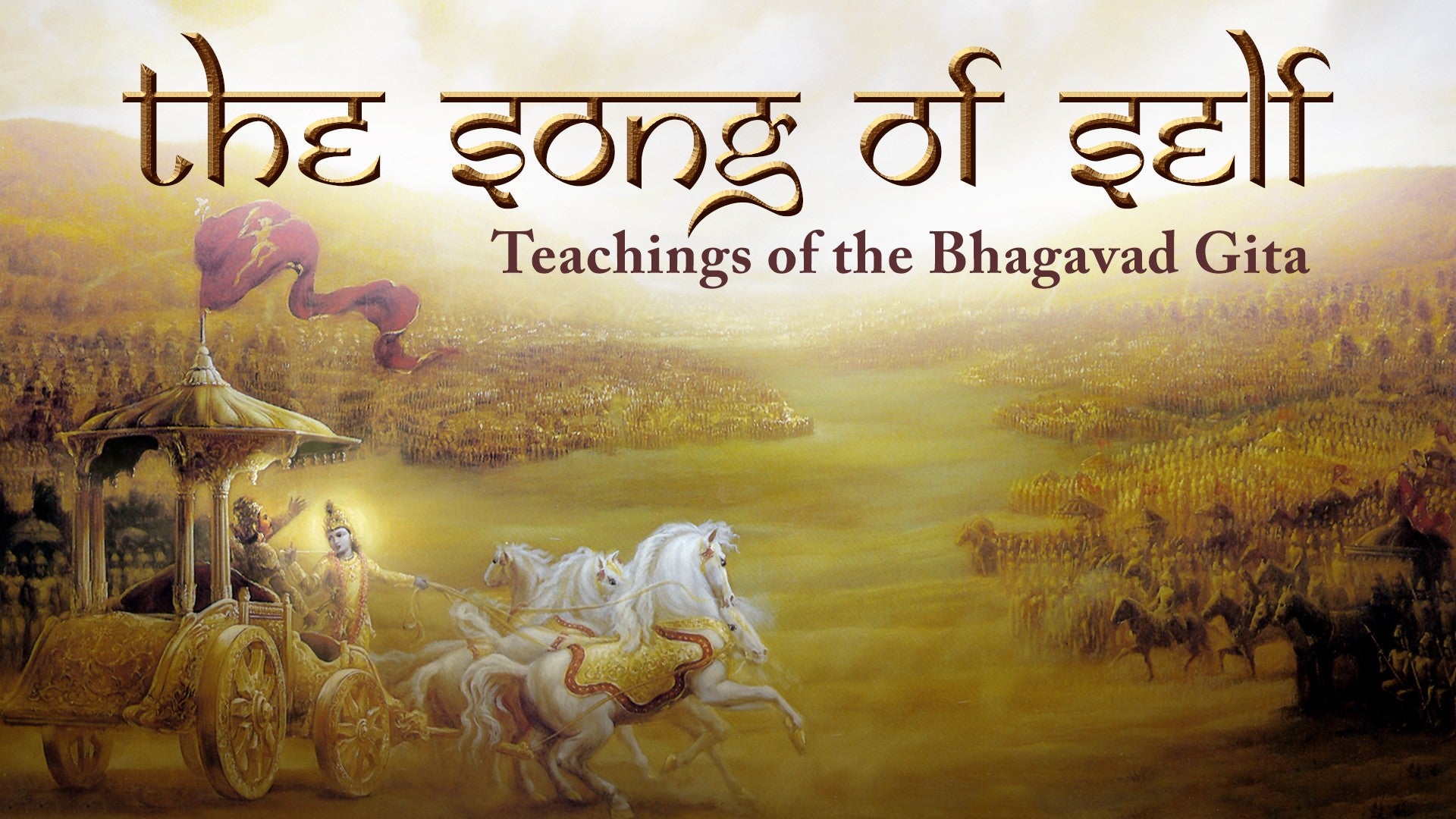Description
Govinda Jaya Jaya, Gopala Jaya Jaya
We sing together to harmonize and unify all parts of our being. Victory to that, our subtlest consciousness, our deepest intuitive wisdom, and to that discerning capacity that guides us home to our truest self.
About This Video
Transcript
Read Full Transcript
So welcome back everyone and we're going to sing a song to Krishna, another song to Krishna and in this song he's referred to by the name Govinda and by Gopala and he's describing some other ways too. So the words in this song is Govinda Jaya Jaya, you can say it together, Govinda Jaya Jaya, Gopala Jaya Jaya, Gopala Jaya Jaya, Radha, Radha, Ramana, Ramana, Hari, Govinda Jaya Jaya, Govinda Jaya Jaya. So Govinda and Gopala, some of you might know the Sanskrit word go, it means cow. So Krishna when he was growing up, he grew up in a nomadic cow herding community. So they kept the cows and they lived along the banks of the river and so Krishna got to be known, one of his names, Gopala, the protector of the cows. Govinda, the one who can lead the cows, look after the cows. So he's the cow herd. So sometimes when people hear this thing, oh that sounds rather familiar, it's a bit like Jesus, the shepherd, the one who leads the flock. So we find this type of image in many different spiritual traditions. So Krishna does the idea, we've come across Krishna as the teacher, he's teaching Arjuna how to unify all the different parts within him. So at the beginning we spoke about the field of yoga practice, we mentioned that yoga recognizes that as human beings within this field of our individual awareness, there are many powers. There are the powers of our senses, the powers of the different aspects of our mind, our bodies, our emotions and the course or journey of yoga is learning to unify all that. So it can all work in a collaborative and complementary way. And so Krishna as Govinda, Gopala, he's the one who knows how to unify all the cows. In other words, all the members of the flock, all the members of the group, all the members of the herd. Now, if you think of a herd, think of sheep for example, you're a skilled shepherd and a good sheepdog or two, you can keep a huge flock moving along relatively together quite easily. What about cows? What type of animal is a cow? What is it like to do? In Sanskrit, they define a cow as one who moves and consumes. Moves, eats, moves, eats like that. When we think about it, that doesn't sound so different to another species that we're kind of familiar with. Yeah, we also move and consume, not just in the sense of eating, but as we move around in life, we're always consuming new experiences, taking on new ideas, taking on new impressions. There's actually a very beautiful shloka, a verse in Sanskrit, 32 syllables, which is quite often used when people are studying the Gita together. They might sing this at the beginning to get them in the mood or to remind them of the beautiful scope and the succinct presentation that is the Gita. And this is how it goes. It says... So this verse, Sarva Upanishad or Gavaha. Gavaha is the plural form of this word go, meaning cows. So Gavaha means the cows. Sarva or Upanishads. All of the Upanishads, they're like the cows. So what does this mean? The Upanishads, this very important body of literature, which is an important kind of source for the yoga teachings. And the Gita is considered the distillation of all of the Upanishadic wisdom. Now the Upanishads are often referred to as a part of the Vedic literature. We're going to hear a little bit more about the Veda in this section of the Gita, in the verses we're going to be coming to quite shortly. But Veda means that which is revealed. And the Veda has two main thrusts, we might say. Firstly, how to live happily and harmoniously in the world, and then once you're doing that, how to know yourself, how to know the essence of this world and the essence of yourself within it. And this second aspect of the Vedic teachings or the Vedic literature, the most important resource or section of the Vedic which we find in those teachings, are what are known as the Upanishads. So they are that section of the Vedic literature which is particularly concerned with ultimate reality and how we can come to understand it and recognize it for ourselves. And the Bhagavad Gita as this kind of super treasured distilled teaching of the yoga tradition is considered to be like a summary of all of the Upanishadic wisdom. And so the first part of this shloka says, shloka just means a Sanskrit verse, having 32 syllables. Sometimes people use shloka to mean any verse, but traditionally it refers to a verse in a particular meter. Saravo Upanishad, all the Upanishads, they're like the cows. So what does this mean? The Upanishads, they were written by different sages, and some of them are very different in style to others. Some of them are very pithy, some of them are really quite long, some of them include stories, some of them include dialogues. So there's many different styles, they range in many different directions. And this is why they refer to as the cows. So if you leave the cows out in a vast fertile land, what will the cows do? They'll roam wherever they want to, they'll roam here and there, and they'll all roam in different directions. And now this is what the Upanishads do. They look out, the different sages looked out at reality from different vantage points. They explored in different ways, and from their explorations they set down things that came to them, things they recognized, understandings they saw as they looked out at nature. And then they wrote down various Upanishadic teachings. But if we then look at the Upanishads, some of them are pointing in this direction, some of them are pointing in that direction, some of them are in this style, because they had it in the Gita, all of it gets, as it were, brought together in a kind of cogent, cohesive form, which is relatively much easier to work with. And so it's the idea that the Gita is the distillation of the Upanishads, which are like the cows. But then the Gita comes along. So we have the Upanishads like the cows, like the cows, ranging all over the place. So we have cows, the cow, special animal we've mentioned before, loved in India, because the cow has the opportunity, has the potential, not just to feed its own young, but to provide valuable nutrition to a wide and extensive population. But if we want to draw the milk from the cow, what do we need? A few different things. We need a container, but you need someone who knows how to milk a cow.
When I was first taught this verse, it was by a Sanskrit teacher in Mysore who has cows. And he says, you think you can milk a cow? You have to know how to do it. Because a cow, you know, Indian cows especially, they're famed for being very gentle, very mild. But if you don't approach the cow in the right way and with enough respect, those cows' legs, if they kick out, not the result you were looking for. So you have to know how to milk the cow. So in the Gita, who is the milker? This is Krishna. So Saravu Upanishad or Gavaha, Dogdha Gopala Nandana. The Dogdha, the milker, is Krishna. He is Gopala Nanda. Nanda means different things. There's a play on words here in the Sanskrit, so we find a lot. He is the Nanda, the son of the leader of the cow herds. This is who Krishna is. And he's also the joy of the leader of the cow herds and all of the cow herds. So Krishna is the milker. He grew up among the cow herding people, so he's an expert milker. The idea being that, yeah, Krishna, he's the supreme, he's Bhagavan, but he's grown up among human beings. So he can milk the Upanishads in a very skillful way, appropriate to the needs of human reality. However, even if you really know how to milk a cow, you need something else to be there if you can extract any milk. The cow, she doesn't give her milk unless the calf is there. Only once she's fed her own calf will she share the surplus. So who's the calf? Parthu Vatsaha. Arjuna, Partha, the son of Pritha, he is the calf. How is Arjuna? We've already said he's got pure intent, and he's also very dear to Krishna. They're very close. And so it's very beautiful. If you think you have a great teacher, what's going to bring the teaching out? If somebody who he loves is in need and is attentive, that will bring the teaching out. And this is how Arjuna is. He shows us how we can draw on the support of Mother Nature to teach us. Because Arjuna is alert, he's attentive, and he admits, he owns, he acknowledges his need. And so he's the calf. Parthu Vatsaha sudheeboktaha. But once the calf is there and the mother cow is given her milk, it's not just the calf that can be nourished. So this verse suggests that anybody, Sudhihi, anybody who wants to make the most of this gift of having a discriminating human awareness, that person can use these teachings for their own nourishment. Parthu Vatsaha sudheeboktaha, dukdangita amritam mahate.
And how is this nourishment of the Gita? It is just the kind of dukdangita amritam mahate, it's the great nectar, it's the great ambrosial nectar of the Gita. And who's it for? All of us, for anyone who's interested. And it comes to us from this teacher, Krishna, who knows what it's like to be a human being and knows what's really useful for us. And so this song that we're going to sing is invoking that energy, that energy that can unify all the parts of ourselves. So we're going to sing Govinda Jaya Jaya, this means victory to the leader of the hurt. In other words, a victory to the leader of our, the team of our individual self. In other words, a victory to our subtlest consciousness, to our deep awareness, to our deep intuitive knowing. Gopala Jaya Jaya, a victory to the one that protects the hurt. Victory is that intuitive wisdom that keeps us safe. Govinda Jaya Jaya, Gopala Jaya Jaya, Radha Ramana Hari Govinda Jaya Jaya. So Hari, another name of Krishna, I mean the one who takes away, who takes away our reflections. Radha Ramana, the one who is beloved, who is the joy of Radha. Now Radha, there's a lot we could say about Radha, but we'll have to be a little bit brief on this occasion. Now Radha, she is, how to say it, she is Krishna's true love. But in the incarnation that Vishnu takes as Krishna, it's part of the scenario that Krishna can never actually really be with his true love. So they know each other when they're growing up, but then when Krishna goes away and gets on with so many of the other things he has to do in his life, he becomes separate from Radha. And so the love of Radha and Krishna, it reminds us of the power of longing. In the Sanskrit there is this idea that the rasa, the taste or the feeling of erotic love is much stronger in absence, generally speaking, than in union. Like if you are deeply in love and you're with your beloved, then your beloved's right there with you. But if you're separated from the beloved, then where is the beloved?
Everywhere. And Radha, she is very discriminating. Krishna was the only one that could make her kind of lose her mind, if you like. And so there's the idea, Radha Ramana Hari Govinda Jaya Jaya. Jaya Jaya means victory. So victory to that discerning capacity that helps us heed the call of our deepest longing to come home to union, to come home to the fullness that we really are. We could say much more about this song. Beautiful thing with these songs is that there's so many layers of symbolic meaning in them, but I think that gives us a nice idea to work with. And so now let's sing together, yeah? So we'll start off calling a response and then we can just sing together. So if you like, just join in and enjoy. All in, Raja Jaya, kopa Jaya Jaya, adha Ramana Hari, all in, Raja Jaya, all in, Raja Jaya, kopa Jaya Jaya, Radha Ramana Hari, all in, Raja Jaya, all in, Raja Jaya, kopa Jaya Jaya, Radha Ramana Hari, all in, Raja Jaya, all in, Raja Jaya, kopa Jaya Jaya, Radha Ramana Hari, all in, Raja Jaya, all in, Raja Jaya, kopa Jaya Jaya, Radha Ramana Hari, all in, Raja Jaya, all in, Raja Jaya, kopa Jaya Jaya, Radha Ramana Hari, all in, Raja Jaya, all in, Raja Jaya, kopa Jaya Jaya, Radha Ramana Hari, all in, Raja Jaya, all in, Raja Jaya, all in, Raja Jaya, Radha Ramana Hari, all in, Raja Jaya, all in, Raja Jaya, kopa Jaya Jaya, Radha Ramana Hari, all in, Raja Jaya, all in, Raja Jaya, all in, Raja Jaya, Radha Ramana Hari, all in, Raja Jaya, all in, Raja Jaya, kopa Jaya Jaya, Radha Ramana Hari, all in, Raja Jaya, all in, Raja Jaya, kopa Jaya Jaya, Raja Jaya, all in, Raja Jaya, all in Raja Jaya, all in, Raja Jaya, All in, Raja Jaya, all in, Raja Jaya, all in, Raja Jaya, Gopadajaya Pranamanahi Govindajaya, Govindajaya Gopadajaya, Govindajaya God be in the Jaya Jaya God be in the Jaya Jaya God be in the Jaya Jaya God be in the Jaya Jaya God be in the Jaya Jaya God be in the Jaya Jaya God be in the Jaya Jaya God be in the Jaya Jaya Gautamma! Gautamma! Gautamma! Gautamma! Gautamma! Chai Jaya, K Chai Jaya, K Chai Jaya, K Chai Jaya, K Chai Jaya, K Chai Jaya, K Chai Jaya, K Chai Jaya, K Golan Dajai Jaya Golan Dajai Jaya Radhamana haiti Golan Dajai Jaya Golan Dajai Jaya Golan Golan Dajai Jaya All in the jaidaya, all in the jaidaya, gopa jai jaya, kra dha dha mana hai. All in the jai jaya, all in the jai jaya, kra dha dha mana hai.
So victory to the power of that deep intuitive longing to guide us home and work with all the different members of the group, all the different parts of ourselves, so we can experience that unity right here, right now in the thick of life.
The Song of Self: Bhagavad Gita: Chapter 2
Comments
You need to be a subscriber to post a comment.
Please Log In or Create an Account to start your free trial.











